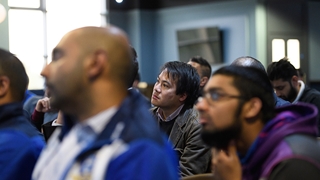
Please read our FAQs below to help you with any queries about The FA's Asian Inclusion Plan.

Please read our FAQs below to help you with any queries about The FA's Asian Inclusion Plan.
As the governing body of football in England, The FA has a responsibility to make the game For All. This means for all diverse communities and people of all backgrounds, whether diverse in terms of gender, ethnicity, disability, age, belief, sexual orientation or gender identity.
In terms of ethnicity, Asian communities are the largest ethnic minority group in England (around 8% of the population) and the most under-represented in almost every area of the grassroots and professional games.
This under-representation is a long-term issue that hasn’t been impacted by some of the good practice and committed people that have gone before us. The FA therefore felt it necessary to create a bespoke plan to try and address this issue. Read The FA's Asian Inclusion Plan below:
This is a long standing and complex question as Asian communities in England are very diverse themselves and are not one group of people. Under the banner of Asian there are around five main ethnicities (Indian, Pakistani, Bangladeshi, Chinese and Sri Lankan) which make up most British Asians.
Additionally, those people could be from several different faith groups, from different regions of their heritage countries, living in different regions of the UK and importantly from different generations of their Asian communities.
For example an older British Bangladeshi who settled in England in the 60s may well have a different life experience and outlook on life to a younger British Bangladeshi teenager who has been born and brought up here.
This diversity within communities make it very difficult to pinpoint the main barriers for all of them, we can only try and identify some of the commonalities for that wide range of communities.
In 2018, at the end of the first phase of The FA’s Asian Inclusion Plan, we worked with independent charity Sporting Equals to research some of the key themes which communities themselves mentioned as issues/barriers: They were:
1) Representation - Mainstream representation rather than Asian only projects
2) Cost – That the game was too expensive for some Asian families
3) Communication – Communities needed more and better communication from football
4) Parental involvement – Asian parents need to be made aware of opportunities in football in order to support them becoming more involved
5) Education and signposting – Asians were unaware of the pathways into and structure of the game
6) Professional game – The professional game needed to deliver more actions and show more interest in Asian communities
One of The FA’s core values is inclusion and making football For All, therefore we try and ensure all that we do is inclusive of all communities. We have recognised though that Asian communities are so under-represented in the game that this issue needs specific interventions to try and start to make an impact.
In 2015, The FA released it’s first Asian inclusion plan and in 2019 the second phase was launched, both named Bringing Opportunities to Communities. The current plan has five pillars, which are the key areas we are trying to influence change in. They are:
1) The FA and it’s Culture
2) Pathways into football
3) The grassroots game
4) Asian Women & Girls
5) Engagement and experience
A document explaining this plan can be downloadedbelow:
Read The FA's Asian Inclusion Plan
September 2019-September 2020 was the period where the first year of this three year plan was delivered and we will be publishing an annual update on this work soon.
Our Asian Inclusion plan for the next three years is set and can be read below:
Read The FA's Asian Inclusion Plan
Inevitably as circumstances change we will have to modify parts of this work. We can only do this through feedback from you, so The FA would request that people sign up to our Asian Inclusion communications and also keep an eye on communications from your local County FA and The FA. This will enable you to take advantage of some of the latest developments.
Sport England and other research indicates that Asian communities are the least active ethnic group in England, in terms of playing sport. Within those communities research points to Asian females being significantly less active than Asian males, making this situation more concerning in terms of both sports participation and the potential health and societal impact.
As this situation is significantly worse than other areas of inclusion in sport, we have set up a separate strand of our work to address this issue specifically and within that work we have set up a large steering group of around 20 Asian females who are from across the football industry. This group is linked to The FA Women’s Board and FA Inclusion Advisory Board so it’s conclusions can gain greater awareness and accountability.
Under The FA’s ethos of football For All, we adopt a fully inclusive definition of Asian. In line with the international football definition of Asian, we define Asian as anyone with a background/identity aligned to any of the 44 nations within the Asian Football Confederation (The AFC is Asian football’s governing body and one of the six confederations making up FIFA).
To see which those nations are, follow the link below:
The FA employ around 800 people across the country and we currently, those who voluntarily declare (around 72% of our workforce), just over 12% describe themselves as BAME (Black, Asian and Minority Ethnic) employees. Of these BAME employees, just over half are Asian (6% of the declaring population).
This compares favourably with most of the sports industry and we are continuing to strive for better ethnicity and gender representation across our organisation. More details of this can be found within our three-year equality, diversity and inclusion plan, In Pursuit of Progress.